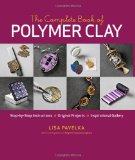The Complete Book of Polymer Clay by Lisa Pavelka
Lisa Pavelka begins her book with a disclaimer. That given all the possibilities of polymer clay, it’s impossible to write a truly complete book about it.
What she does try to do in this book is to provide instruction for a lot of the techniques used in working with polymer clay in an easily understandable format with lots of photos. She reassures people new to the medium through out that getting professional results happens quickly with practice.
It looks a little intimidating for an absolute beginner, don’t be intimidated. If polymer clay is something you’ve been interested in working with, this book is an excellent introduction to many of the things that can be done with it. The focus of the book is on embellishment rather than sculpting and the techniques can used to make truly impressive beads, focals and cabochons for beading.
She starts with an introduction to the medium, a brief history, the types of clay available,color basics, making color chip charts, the sorts of tools you’ll be using and improvising with and how to handle, cure and store clay.
After that you get into the playing with clay parts of the book. Starting with the Skinner blend and the sorts of canes and techniques you can do with that. Each chapter covers a different technique, and how it can be used in application. Millefiori, image transfers, mokume gane and many other techniques. There are a bunch of faux effects so you can learn how to make an impressive simulation of wood veneer inlays, ivory, cinnabar or one of my favorites, dichroic glass effects.
The last part of the book has a few projects that can be stepping stones to your own creations, a gorgeous gallery that shows how many fine jewelry and art techniques can be done with polymer clay, and a troubleshooting section.
I really like this book, and it will have a permanent place in my polymer clay books.
You can get the book directly from the publisher, Taunton Press or you can buy it from Amazon using the link below.

